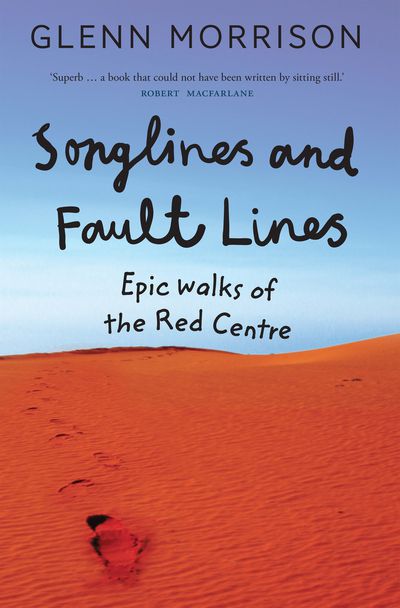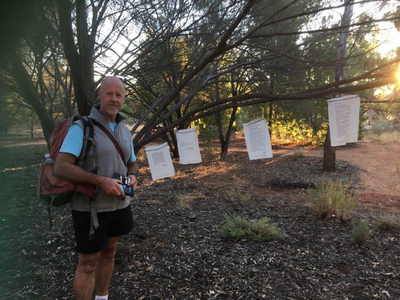←Back to Songlines and Fault Lines

An extract from “Songlines and Fault Lines”
It was a Saturday afternoon, summer 2007, when my wife, Fiona, called for a lift from the Alice Springs pool. For a small town in the desert, the pool is well equipped. Sited in the Gap district just south of the CBD, it’s also handy and we do laps there most days. When I arrived, however, something was amiss. Outside the pool entry gate, Fiona sat on the footpath with a middle-aged Aboriginal woman, both of them cross-legged.
‘She wants to be taken to hospital,’ Fiona said.
A glance at my watch told me we’d have to be quick; it wasn’t long until I had to pick up my daughter. I asked the woman her name.
‘Rosie,’ she said, gazing at the concrete. I told her everything would be OK, and knelt next to her: ‘What’s wrong Rosie?’
‘Sick,’ Rosie said. She looked up then, nodding at her left side. ‘Bastard stab me.’
‘Who?’ I asked.
‘Husband.’
‘Your husband?’
‘Daughter’s. Wouldn’t give money for grog.’
I placed my hand gently to her shoulder: ‘Where did he stab you?’
With her right hand Rosie lifted her T-shirt, and with the other cupped and lifted her left breast. There, marking the expanse of brown skin over her ribs, were two neat slits. Each was at least 2 centimetres long. Blood stained Rosie’s stomach, but thankfully the wounds had stopped bleeding. I phoned triple-0 to tell them a woman had been stabbed.
‘It could be a while love,’ came the answer. ‘There’s a bit on just now; is she still bleeding?’
I looked at Rosie then at my wife. To be honest, I was a bit thrown by the response. Surely a stab wound was important? Admittedly, Rosie was breathing fine. And no, she wasn’t bleeding. But still.
I told the woman on the phone Rosie seemed OK, for now. And that she actually seemed relatively comfortable where she was. Rather than risk disturbing the wound by taking her to hospital—only two blocks away—Fiona and I decided we would wait with her for the ambulance. When they arrived about twenty minutes later, the paramedics couldn’t have been kinder.
It was around the same time that the chief surgeon at the Alice Springs Hospital, Dr Jacob Jacobs, published statistics for the number of stab wounds treated by medicos there. Between 1998 and 2005 the hospital logged 1500 admissions for stab wounds, 605 of them Aboriginals, and sixteen of those dead on arrival. Published in the ANZ Journal of Surgery, mainstream media soon picked up on the findings.
In July 2007, the ABC’s Lateline revealed ‘disturbing stabbing figures’ had surfaced in Alice Springs. In March the following year, the Brisbane Courier Mail cited the same figures, adding that almost 40 per cent of the stabbings were thigh injuries, ‘most likely meted out by Aboriginal elders as traditional punishment’. Headlines dubbed Alice Springs the ‘world’s stabbing capital’.
The tag stuck. By December of 2008, Natasha Robinson for The Australian was reporting that T-shirts were being sold in the town ‘that are no joke: Alice Springs—Stabbing Capital of the World’.
The problem with Robinson’s report and others like it was that they told an incomplete story: back in April 2008, Dr Jacobs had reported to the ABC that stabbings treated at Alice Springs hospital had halved since his previous report. In the same interview, Dr John Boffa of the Alice Springs People’s Alcohol Action Coalition pointed to alcohol restrictions and a 10 per cent reduction in the consumption of pure alcohol as being responsible for the improvement. Nevertheless, to the rest of Australia and international observers, Alice Springs remained ‘the stabbing capital’.
The label came hard on the heels of Alice Springs Crown Prosecutor Nanette Rogers’ horrific revelations of widespread sexual abuse and violence against Aboriginal children and babies, broadcast—again on Lateline—on 15 May 2006. Many would later conclude that Rogers’ interview was what sparked the momentous government actions that came next. It was certainly a catalyst. But while her report came as a shock to the rest of Australia, it was old news to Territorians. News outlets had reported on such matters for years, but rarely did their reports gain traction in national or interstate media.
Nonetheless, prompted by the ABC report, on 8 August 2006, Clare Martin, Chief Minister of the Northern Territory, commissioned an investigation by the Northern Territory Board of Inquiry into the Protection of Aboriginal Children from Sexual Abuse. The inquiry was headed by Rex Wild QC, the recently retired Northern Territory Director of Public Prosecutions, and the prominent Aboriginal leader Pat Anderson. A year earlier, Wild had presided over the conviction of Broome diesel mechanic Bradley John Murdoch for the murder of British backpacker Peter Falconio.
The inquiry took eight months, the board finally making public its report entitled Ampe Akelyernemane Meke Mekarle: ‘Little Children are Sacred’ on 15 June 2007. Amid some intense politics between federal and territory tiers of government, the Martin Labor Government was accused of sitting on the report, which it had received some six weeks earlier on 30 April 2007.
With a tough federal election battle looming for the conservatives, it was in Prime Minister John Howard’s interests to act politically, and so he decided it was time to step in. Less than a week after the report’s release, on 21 June 2007, the federal government launched a ‘national emergency response to protect Aboriginal children in the Northern Territory from sexual abuse and family violence’.

The plan had bipartisan support for a range of measures under a five-year timeframe to be applied mainly to remote communities in the Northern Territory. These measures included more police and military personnel, restrictions on alcohol and pornography, compulsory health checks for children, new housing construction, and welfare income management.
A week later, troops from the Australian Army moved into Alice Springs, from where they fanned out to several remote settlements. A six-month ban on alcohol was immediately enforced, even though public drinking had already been banned in Alice Springs the previous month. Doctors and other health workers with no experience of the region or its challenges were flown in. Locals already working in the field protested the move, pleading that existing programs were working but needed more consistent funding, and that change would take time. The day the army arrived, however, Mal Brough, the Minister for Indigenous Affairs, told the Melbourne Herald Sun—with sound-bite precision—that ‘a 20-year plan is not going to cut the mustard for the children that are going to get hurt tonight’.
From the start, confusion reigned on remote communities and in the Alice Springs town camps. For example, Conrad Wiseman, the chairman of Ilparpa Town Camp south of the Heavitree Gap, told me: ‘We haven’t heard anything about [the plan]. That’s [only] for the bush communities’. It wasn’t. As it turned out, Intervention legislation was amended early in 2008 to include them.
Wiseman was equally unaware of plans to halve all Centrelink payments to guarantee the money was used for essential supplies such as food. When income management and the Centrelink Basics card were introduced to inhibit the sale of alcohol, tobacco and pornography, many shops—and particularly bush stores on remote communities—were unable to use the system. The result was an outpouring of Aboriginal people from remote settlements and into Alice Springs, where they could use their Basics card at Woolworths or Coles. Very few people, including Aboriginals themselves and those already working in Indigenous welfare and support, had any idea of exactly what might happen next. As Australian Army trucks dragged clouds of red dust towards remote communities, some Aboriginal women hid their children, for fear they might be ‘stolen’.
This is an extract from Glenn Morrison's book Songlines and Fault Lines: Epic walks of the Red Centre.
